These archive pages are provided in order to make it easier for you to find items
that you remember seeing on the Airplanes and Rockets homepage. Of course probably
the easiest way to find anything on the website is to use the "Search AAR" box at
the top of every page.
1 |
2 |
3 |
4 |
5 |
6 |
7 |
8 |
9 |
10 |
11 |
12 |
13 |
14 |
15 |
16 |
17 |
18 |
19 |
20
21 |
22 |
23 |
24 |
25 |
26 |
27 |
28 |
29 |
30 |
31 |
32 | 33

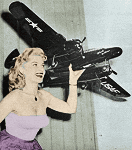 It's the age-old problem of 20% of the people
doing 80% of the work, or maybe it's 10% of the people doing 90% of work. In 1957
when this issue of American Modeler magazine was published, clubs were
suffering under the same lack of willingness on the part of its members to do little
(or no) more than pay annual dues and let someone else run the club business, contests,
and promotions. The author here makes a few suggestions for how to get more people
to participate in activities. A real sign of the times is how one idea was to segment
aeromodeling
clubs into groups focusing on free flight, control line, and the newfangled
radio control. I guess there are very few "diverse" clubs these days. BTW, the article
refers to the boy in the first photo as both Billy Swope and Billy Snope. If you
know... It's the age-old problem of 20% of the people
doing 80% of the work, or maybe it's 10% of the people doing 90% of work. In 1957
when this issue of American Modeler magazine was published, clubs were
suffering under the same lack of willingness on the part of its members to do little
(or no) more than pay annual dues and let someone else run the club business, contests,
and promotions. The author here makes a few suggestions for how to get more people
to participate in activities. A real sign of the times is how one idea was to segment
aeromodeling
clubs into groups focusing on free flight, control line, and the newfangled
radio control. I guess there are very few "diverse" clubs these days. BTW, the article
refers to the boy in the first photo as both Billy Swope and Billy Snope. If you
know...
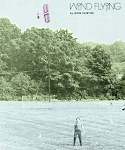 Airplanes and Rockets website visitor Lars
B. wrote from Sweden requesting that I scan this "Wind Flying" article from
the September 1972 edition of American Aircraft Modeler magazine. It describes
a method for replacing engines and motors with human power for preforming some pretty
impressive C/L aerobatics on windy days. Basically, you drag the model airplane
around on its control lines, which often required not just turning in a circle while
standing in one place, but walking around a small circle in order to get more speed.
If there is any wind, you need to put extra effort into the pulling when moving
into the wind. I can remember doing this as a teenager, only I did it with the engine
in place but not running - usually because I could not afford to buy enough fuel
to fly as often as preferred... Airplanes and Rockets website visitor Lars
B. wrote from Sweden requesting that I scan this "Wind Flying" article from
the September 1972 edition of American Aircraft Modeler magazine. It describes
a method for replacing engines and motors with human power for preforming some pretty
impressive C/L aerobatics on windy days. Basically, you drag the model airplane
around on its control lines, which often required not just turning in a circle while
standing in one place, but walking around a small circle in order to get more speed.
If there is any wind, you need to put extra effort into the pulling when moving
into the wind. I can remember doing this as a teenager, only I did it with the engine
in place but not running - usually because I could not afford to buy enough fuel
to fly as often as preferred...
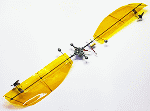 "The relatively simple and now quite pervasive
quadrotor design for drones emphasizes performance and manufacturability, which
is fine, but there are some trade-offs - namely, endurance. Four motors with rapidly
spinning tiny blades suck up battery power, and while consumer drones have mitigated
this somewhat by hauling around ever-larger batteries, the fundamental problem is
one of efficiency in flight. In a paper published this week in Science Robotics,
researchers from the City University of Hong Kong have come up with a
drone inspired by maple seeds
that weighs less than 50 grams but can hold a stable hover for over 24 minutes.
Maple seed pods, also called samaras, are those things you see whirling down from
maple trees in the fall, helicopter style. The seed pods are optimized for maximum
air time through efficient rotating flight, thanks to an evolutionary design process
that rewards the distance traveled from the parent tree..." "The relatively simple and now quite pervasive
quadrotor design for drones emphasizes performance and manufacturability, which
is fine, but there are some trade-offs - namely, endurance. Four motors with rapidly
spinning tiny blades suck up battery power, and while consumer drones have mitigated
this somewhat by hauling around ever-larger batteries, the fundamental problem is
one of efficiency in flight. In a paper published this week in Science Robotics,
researchers from the City University of Hong Kong have come up with a
drone inspired by maple seeds
that weighs less than 50 grams but can hold a stable hover for over 24 minutes.
Maple seed pods, also called samaras, are those things you see whirling down from
maple trees in the fall, helicopter style. The seed pods are optimized for maximum
air time through efficient rotating flight, thanks to an evolutionary design process
that rewards the distance traveled from the parent tree..."
 Flying Aces magazine had a regular feature
of aviation humor entitled "Wisecrack-Ups." You can tell from the gag lines and
topics that it reflects a very different time that was the 1930s. December 1939,
when this issue was published was, was very shortly after World War II had
begun in Europe, yet one of the comics has an enemy observation balloon, Sopwith
Camels, and Fokker D7s, left over from World War I. Most of the content is
uncredited, except for the artwork. Mention is made of the G.A.R., which is not
familiar to me. The best thing I could come up with for it given the era is maybe
the Grand Army of the Republic... Flying Aces magazine had a regular feature
of aviation humor entitled "Wisecrack-Ups." You can tell from the gag lines and
topics that it reflects a very different time that was the 1930s. December 1939,
when this issue was published was, was very shortly after World War II had
begun in Europe, yet one of the comics has an enemy observation balloon, Sopwith
Camels, and Fokker D7s, left over from World War I. Most of the content is
uncredited, except for the artwork. Mention is made of the G.A.R., which is not
familiar to me. The best thing I could come up with for it given the era is maybe
the Grand Army of the Republic...
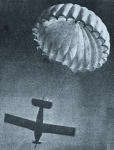 When
I first saw this article from a 1946 edition of Radio News, I did a double-take
on the author's name, thinking it was written by long-time model aviation author
and magazine editor William "Bill" Winter. It was actually done by a fellow named
Winters (not Winter). An enthusiastic radio control (R/C) evangelist in his day,
Bill Winter wrote many pieces for electronics magazines such as Popular Electronics.
As I have noted in the past, hobbyists in the electronics realm, as well as in the
fields of aircraft and rocket design, contribute mightily to the state of the art.
Such is also the case in many other arts and sciences. Here we have a report of
some of the earliest radio controlled flying "drones,"
as we call them today. They are a far cry from the palm-size, gyro-stabilized examples
available from commercial distributors nowadays. American film star Reginald Denny
was a pioneer in the development of remote controlled drone aircraft... When
I first saw this article from a 1946 edition of Radio News, I did a double-take
on the author's name, thinking it was written by long-time model aviation author
and magazine editor William "Bill" Winter. It was actually done by a fellow named
Winters (not Winter). An enthusiastic radio control (R/C) evangelist in his day,
Bill Winter wrote many pieces for electronics magazines such as Popular Electronics.
As I have noted in the past, hobbyists in the electronics realm, as well as in the
fields of aircraft and rocket design, contribute mightily to the state of the art.
Such is also the case in many other arts and sciences. Here we have a report of
some of the earliest radio controlled flying "drones,"
as we call them today. They are a far cry from the palm-size, gyro-stabilized examples
available from commercial distributors nowadays. American film star Reginald Denny
was a pioneer in the development of remote controlled drone aircraft...
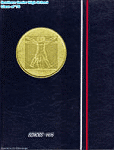 These images were scanned from my 1976 yearbook
for
Southern Senior High School in Harwood, Maryland.. Only pages with information
on Seniors is included. Birthdates have been covered over, but everything else remains.
Please let me know if you would like your picture and/or information removed. On
the other hand, if you would like to send additional information for posting or
would like me to send you the full-resolution scan of your page, then please send
me an e-mail. A full list of all the names that go with these photos can be found
at the bottom of this page. Having them in text format (versus a photo) will allow
search engines to find your name and associate it with Southern Senior High School.
Oh, and yes, all the photos are in B&W; there are only eight pages with color
in the entire book... These images were scanned from my 1976 yearbook
for
Southern Senior High School in Harwood, Maryland.. Only pages with information
on Seniors is included. Birthdates have been covered over, but everything else remains.
Please let me know if you would like your picture and/or information removed. On
the other hand, if you would like to send additional information for posting or
would like me to send you the full-resolution scan of your page, then please send
me an e-mail. A full list of all the names that go with these photos can be found
at the bottom of this page. Having them in text format (versus a photo) will allow
search engines to find your name and associate it with Southern Senior High School.
Oh, and yes, all the photos are in B&W; there are only eight pages with color
in the entire book...
 As is the case with so much as you get older
- and especially when you've gotten a LOT older - it is rather sad to be reminded
of all the things that played a large role in your lifetime that are no longer around
(both people and things). Back in the day, I never considered that some time in
the distant future so many of the things I took for granted would not exist any
more. Montgomery Ward, Sears & Roebuck, Pontiac, Oldsmobile, Hechinger Lumber,
Woolworth, Toys R Us, Howard Johnson, Circuit City, Eastern Airlines, Western Auto,
Dart Drug, Radio Shack, Allied Radio, Heathkit, RCA, A&P Grocery, Pantry Pride,
KB Toys, and many more that do not immediately come to mind were the brick and mortar
places we of my generation (born in 1958) knew so well. In the model building world,
a similar list of long gone and not so long gone companies could be made as well.
Sterling Models, of course, is amongst them, along with Aamco, America's Hobby
Center, Marks Models, Airtronics, Berkeley Models, Kraft Radio, Hobby People, Jetco,
Cox, Scientific Models, Tatone, and many more. For nostalgia's sake, here is an
advertisement from a 1960 issue of American Modeler magazine, which itself
is no longer in existence... As is the case with so much as you get older
- and especially when you've gotten a LOT older - it is rather sad to be reminded
of all the things that played a large role in your lifetime that are no longer around
(both people and things). Back in the day, I never considered that some time in
the distant future so many of the things I took for granted would not exist any
more. Montgomery Ward, Sears & Roebuck, Pontiac, Oldsmobile, Hechinger Lumber,
Woolworth, Toys R Us, Howard Johnson, Circuit City, Eastern Airlines, Western Auto,
Dart Drug, Radio Shack, Allied Radio, Heathkit, RCA, A&P Grocery, Pantry Pride,
KB Toys, and many more that do not immediately come to mind were the brick and mortar
places we of my generation (born in 1958) knew so well. In the model building world,
a similar list of long gone and not so long gone companies could be made as well.
Sterling Models, of course, is amongst them, along with Aamco, America's Hobby
Center, Marks Models, Airtronics, Berkeley Models, Kraft Radio, Hobby People, Jetco,
Cox, Scientific Models, Tatone, and many more. For nostalgia's sake, here is an
advertisement from a 1960 issue of American Modeler magazine, which itself
is no longer in existence...
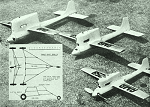 Control line speed has been around for many
decades. As with all other areas of specialty, the state of the art has advanced
significantly since the time of Bill Wisniewski's reign as king of the C/L speed
domain with his venerable
Pink Ladies. Today's
C/L speed models have a single long inboard wing and often have computer-designed
airfoils and fuselage shapes. In the 1958 timeframe when this story appeared in
American Modeler magazine, the record speed was in the 160 mph range. The
video below shows a new F2A world speed record of 208 mph being set in October of
2009... Control line speed has been around for many
decades. As with all other areas of specialty, the state of the art has advanced
significantly since the time of Bill Wisniewski's reign as king of the C/L speed
domain with his venerable
Pink Ladies. Today's
C/L speed models have a single long inboard wing and often have computer-designed
airfoils and fuselage shapes. In the 1958 timeframe when this story appeared in
American Modeler magazine, the record speed was in the 160 mph range. The
video below shows a new F2A world speed record of 208 mph being set in October of
2009...
 This website
exists entirely on the support of its visitors by way of a small percentage earned
with your
Amazon.com purchases. It typically works out to less than $10
per month. That barley covers the domain registration and secure server fees. If
you plan to buy items via
Amazon.com, please begin your shopping session from the AirplanesAndRockets.com
website so that I get credit for it. Doing so does not cost you anything extra.
Thank you for your support. This website
exists entirely on the support of its visitors by way of a small percentage earned
with your
Amazon.com purchases. It typically works out to less than $10
per month. That barley covers the domain registration and secure server fees. If
you plan to buy items via
Amazon.com, please begin your shopping session from the AirplanesAndRockets.com
website so that I get credit for it. Doing so does not cost you anything extra.
Thank you for your support.
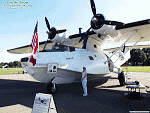 On August 26, 2013, Melanie and I toured
the inside of this Consolidated PBY-5A Canso
(PBY-5 is the Catalina) while it was on display at the Erie International Airport.
It was on tour by a crew from Canada, which is appropriate since it was this particular
airplane was manufactured in Canada in 1944 by the Vickers company. World War II
ended before it could ever see combat reconnaissance duty. The PBY-5A has a wingspan
of 104 feet 0 inches and is powered by a pair of 1200 horsepower Pratt & Whitney
R-1830-92 Twin Wasp radial engines. Top speed is 179 mph. It sported six .303 Vickers
machine guns and could carry up to 2000 pounds of bombs and depth charges. Hopefully,
these photos will be of use to scale model researchers... On August 26, 2013, Melanie and I toured
the inside of this Consolidated PBY-5A Canso
(PBY-5 is the Catalina) while it was on display at the Erie International Airport.
It was on tour by a crew from Canada, which is appropriate since it was this particular
airplane was manufactured in Canada in 1944 by the Vickers company. World War II
ended before it could ever see combat reconnaissance duty. The PBY-5A has a wingspan
of 104 feet 0 inches and is powered by a pair of 1200 horsepower Pratt & Whitney
R-1830-92 Twin Wasp radial engines. Top speed is 179 mph. It sported six .303 Vickers
machine guns and could carry up to 2000 pounds of bombs and depth charges. Hopefully,
these photos will be of use to scale model researchers...
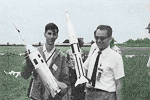 Whenever I look at articles like this one
in American Aircraft Modeler magazine of the
1967 model rocketry nationals
(NARAM-9) showing people from 40+ years ago, I always wonder what they are doing
today. Kids that were 16 in 1967 are 60 today! Many of the adults, if they are still
living, are in their 80s. Are they still flying model rockets? Are they in good
health? Has life been good to them? Time can be a cruel master, or it can also be
a benevolent guardian. But, at the time nobody was thinking about where they would
be or what they would be doing in the year 2011; their only concern was the competition
at hand and having a good time. Note the number of Ph.Ds in the crowd! Back in the
day, model rocketry was a big part of preparing young men (and a few young women)
for a career in astronautics... Whenever I look at articles like this one
in American Aircraft Modeler magazine of the
1967 model rocketry nationals
(NARAM-9) showing people from 40+ years ago, I always wonder what they are doing
today. Kids that were 16 in 1967 are 60 today! Many of the adults, if they are still
living, are in their 80s. Are they still flying model rockets? Are they in good
health? Has life been good to them? Time can be a cruel master, or it can also be
a benevolent guardian. But, at the time nobody was thinking about where they would
be or what they would be doing in the year 2011; their only concern was the competition
at hand and having a good time. Note the number of Ph.Ds in the crowd! Back in the
day, model rocketry was a big part of preparing young men (and a few young women)
for a career in astronautics...
 "Stuttgart, Germany-based H2Fly has set what
it believes represents a new world altitude record for a hydrogen-powered passenger
aircraft, the developer of hydrogen fuel cell applications for aviation reported
on April 19. Besides flying its
HY4 demonstrator on April 13 to an altitude of 7,230 feet, H2Fly took the aircraft
on a 77-mile journey between Stuttgart and Friedrichshafen on April 12, marking
the first time anyone has piloted a hydrogen-electric passenger aircraft between
two major airports, the company added. The aircraft flew the mission to Friedrichshafen
to participate in the Aero Friedrichshafen airshow, scheduled to take place from
April 27 to April 30. The appearance will mark the first time the company has displayed
the HY4 to the general public. Testing of the aircraft has taken place exclusively
in an area around Stuttgart Airport, which serves as a long-term partner of H2Fly
and plays a key role in supporting the company with its infrastructure..." "Stuttgart, Germany-based H2Fly has set what
it believes represents a new world altitude record for a hydrogen-powered passenger
aircraft, the developer of hydrogen fuel cell applications for aviation reported
on April 19. Besides flying its
HY4 demonstrator on April 13 to an altitude of 7,230 feet, H2Fly took the aircraft
on a 77-mile journey between Stuttgart and Friedrichshafen on April 12, marking
the first time anyone has piloted a hydrogen-electric passenger aircraft between
two major airports, the company added. The aircraft flew the mission to Friedrichshafen
to participate in the Aero Friedrichshafen airshow, scheduled to take place from
April 27 to April 30. The appearance will mark the first time the company has displayed
the HY4 to the general public. Testing of the aircraft has taken place exclusively
in an area around Stuttgart Airport, which serves as a long-term partner of H2Fly
and plays a key role in supporting the company with its infrastructure..."
 Don't
miss this chance to observe one of the longest possible
lunar eclipses
tonight, Sunday, May 15th - a
super flower blood moon. The earth's umbral shadow first touches the edge at
10:27 pm EDT, then totality begins at 11:29 pm. The 85-minute-long total
eclipse is midway at 12:11 am, then leaves the umbral shadow at 12:53 am.
A lesser darkening of the moon happens on both sides of the eclipse while in the
earth's penumbral shadow, but it is not as stark. A second, nearly identical, lunar
eclipse will occur in November of this year, so if the weather does not cooperate
in allowing you to see this one, maybe you will get luckier in half a year. The
skies here in Greensboro, NC, are forecast to be clear tonight. I hope yours are,
too. Don't
miss this chance to observe one of the longest possible
lunar eclipses
tonight, Sunday, May 15th - a
super flower blood moon. The earth's umbral shadow first touches the edge at
10:27 pm EDT, then totality begins at 11:29 pm. The 85-minute-long total
eclipse is midway at 12:11 am, then leaves the umbral shadow at 12:53 am.
A lesser darkening of the moon happens on both sides of the eclipse while in the
earth's penumbral shadow, but it is not as stark. A second, nearly identical, lunar
eclipse will occur in November of this year, so if the weather does not cooperate
in allowing you to see this one, maybe you will get luckier in half a year. The
skies here in Greensboro, NC, are forecast to be clear tonight. I hope yours are,
too.
 The spell checker sure gets a workout with
stories from these vintage magazines, specially ones from in the 1920s and 1930s.
Common words were sometimes spelled a bit differently than today, and other words
are rarely seen anymore. And then there is the mix of foreign words and names of
people and places relating to World War I, which had only ended ten to fifteen
years prior (1919). Such is the case here in this 1934 issue of Flying Aces
magazine in a piece called "Gliding in
Russia," and even more so in the fictional wartime stories like "The Ghost from
G−2." The "Iron Curtain" is a term adopted at the end of World War II to describe
the imaginary line through Europe that divided Russia's Communist world from the
Western Democracies; however, Iron Curtain was also used in World War I. Russia
had for a long time endeavored to keep its citizens from learning about the benefits
earned by peoples of free nations, including superior medical care, food, clothing,
appliances, transportation, housing, mental health, etc. At the same time it kept
outsiders from reporting on the internal situation of its territories. You can be
sure that stories like this one were orchestrated by the Bolsheviks of the Politburo... The spell checker sure gets a workout with
stories from these vintage magazines, specially ones from in the 1920s and 1930s.
Common words were sometimes spelled a bit differently than today, and other words
are rarely seen anymore. And then there is the mix of foreign words and names of
people and places relating to World War I, which had only ended ten to fifteen
years prior (1919). Such is the case here in this 1934 issue of Flying Aces
magazine in a piece called "Gliding in
Russia," and even more so in the fictional wartime stories like "The Ghost from
G−2." The "Iron Curtain" is a term adopted at the end of World War II to describe
the imaginary line through Europe that divided Russia's Communist world from the
Western Democracies; however, Iron Curtain was also used in World War I. Russia
had for a long time endeavored to keep its citizens from learning about the benefits
earned by peoples of free nations, including superior medical care, food, clothing,
appliances, transportation, housing, mental health, etc. At the same time it kept
outsiders from reporting on the internal situation of its territories. You can be
sure that stories like this one were orchestrated by the Bolsheviks of the Politburo...
 The April 1960 issue of American Modeler
magazine provided this octet of handy
tricks and tips for model airplane building in its monthly "Sketchbook" feature.
Readers write in with ideas they came up with to solve commonly encountered issues
with hardware, framework construction and covering, painting, trimming out a model
for good flight characteristics, engine operation, and others. Many might seem obvious,
but such is often the case after you see a solution, kind of like in school when
working a math or physics problem and looking at the answer in the back of the book.
A couple of the suggestions here are things I have done, such as running a nut up
on a bolt prior to cutting the bolt so that it can then clean up the threads as
it is removed. I also used to put a piece of fuel tubing between the fuel/air nipples
on the fuel tanks of Cox Babe Bees to facilitate flying inverted. The homemade long
drill bit trick was made in order to make holes through lamps I turned on my lathe... The April 1960 issue of American Modeler
magazine provided this octet of handy
tricks and tips for model airplane building in its monthly "Sketchbook" feature.
Readers write in with ideas they came up with to solve commonly encountered issues
with hardware, framework construction and covering, painting, trimming out a model
for good flight characteristics, engine operation, and others. Many might seem obvious,
but such is often the case after you see a solution, kind of like in school when
working a math or physics problem and looking at the answer in the back of the book.
A couple of the suggestions here are things I have done, such as running a nut up
on a bolt prior to cutting the bolt so that it can then clean up the threads as
it is removed. I also used to put a piece of fuel tubing between the fuel/air nipples
on the fuel tanks of Cox Babe Bees to facilitate flying inverted. The homemade long
drill bit trick was made in order to make holes through lamps I turned on my lathe...
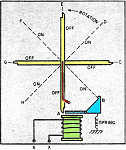 If you're still using the "old" one-arm
escapements in your radio controlled model airplane, you're probably also still
using that "greasy kid stuff" in your hair as well. Just like the hip guy has switched
to Vitalis, the hip modeler has switched to multi-arm escapements that allow more
than just full left/right or full up/down throw on the rudder or elevator, respectively.
Today's equivalent would be advocating for the use of digital servos versus the
"old" analog servos. The more things change, the more they stay the same. This article
entitled, "3 and 4 Finger
R/C Escapements," appeared in a 1955 issue of Popular Electronics magazine. If you're still using the "old" one-arm
escapements in your radio controlled model airplane, you're probably also still
using that "greasy kid stuff" in your hair as well. Just like the hip guy has switched
to Vitalis, the hip modeler has switched to multi-arm escapements that allow more
than just full left/right or full up/down throw on the rudder or elevator, respectively.
Today's equivalent would be advocating for the use of digital servos versus the
"old" analog servos. The more things change, the more they stay the same. This article
entitled, "3 and 4 Finger
R/C Escapements," appeared in a 1955 issue of Popular Electronics magazine.
 Here is a nifty little project for those
of you who still actually build your models. Finding plans for a flight-proven rubber
band-powered helicopter is rare. This construction article and plans for the
Unicopter, a one-bladed
chopper by Mr. Bill Hannan, appeared in the May 1973 edition of American Aircraft
Modeler. It can be made out of a handful of materials that are probably laying around
your hobby bench area. It might not be as exciting as a Blade MCX2 coaxial rotor
RC helicopter, but... oh wait, it actually might just be as exciting after all... Here is a nifty little project for those
of you who still actually build your models. Finding plans for a flight-proven rubber
band-powered helicopter is rare. This construction article and plans for the
Unicopter, a one-bladed
chopper by Mr. Bill Hannan, appeared in the May 1973 edition of American Aircraft
Modeler. It can be made out of a handful of materials that are probably laying around
your hobby bench area. It might not be as exciting as a Blade MCX2 coaxial rotor
RC helicopter, but... oh wait, it actually might just be as exciting after all...
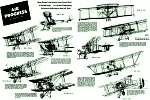 By the time these aeroplanes arrived on
the world's airfields, barely a decade had passed since Wilbur and Oliver Wright
made their famous flight in 1903 at Kitty Hawk. World War I broke out in the
middle of 1914, and planners quickly realized the value of air power as soon as
daring pilots proved the unmatched ability (by ground forces) ability to conduct
surveillance and attacks well behind enemy lines. Avoiding ground fire was a relatively
simple matter of flying high enough to keep out or range of bullets and rockets.
However, it was not long before opposing forces found themselves battling each other
high above the ground battle. Air-to-air combat had begun, proving the ruggedness
of both man and machine. A time period of 1908 through 1919 is presented in this
installment of "Air
Progress" appearing in a 1960 issue of American Modeler magazine. Biplanes stilled
ruled the day, with monoplanes being too fragile to hold up under the demands of
high-G aerobatic maneuvering... By the time these aeroplanes arrived on
the world's airfields, barely a decade had passed since Wilbur and Oliver Wright
made their famous flight in 1903 at Kitty Hawk. World War I broke out in the
middle of 1914, and planners quickly realized the value of air power as soon as
daring pilots proved the unmatched ability (by ground forces) ability to conduct
surveillance and attacks well behind enemy lines. Avoiding ground fire was a relatively
simple matter of flying high enough to keep out or range of bullets and rockets.
However, it was not long before opposing forces found themselves battling each other
high above the ground battle. Air-to-air combat had begun, proving the ruggedness
of both man and machine. A time period of 1908 through 1919 is presented in this
installment of "Air
Progress" appearing in a 1960 issue of American Modeler magazine. Biplanes stilled
ruled the day, with monoplanes being too fragile to hold up under the demands of
high-G aerobatic maneuvering...
 "SpinLaunch
is an innovative new space technology company that has created an alternative method
for putting 200 kilogram class satellites into low earth orbit. Unlike traditional
fuel-based rockets, SpinLaunch uses a ground-based, electric powered kinetic launch
system that delivers a substantially less expensive and environmentally sustainable
approach to space access. On October 22nd, 2021, the Suborbital Accelerator came
to life. Comprised of the key components needed for the Orbital Launch System, the
Suborbital Accelerator is a critical stepping stone in SpinLaunch's path to orbit.
SpinLaunch is building enterprise class satellites that are compatible with kinetic
launch without compromising cost, performance, or mass. We've developed a catalog
of optimized subsystems and fully integrated turnkey solutions to deliver less expensive,
more scalable access to space... " "SpinLaunch
is an innovative new space technology company that has created an alternative method
for putting 200 kilogram class satellites into low earth orbit. Unlike traditional
fuel-based rockets, SpinLaunch uses a ground-based, electric powered kinetic launch
system that delivers a substantially less expensive and environmentally sustainable
approach to space access. On October 22nd, 2021, the Suborbital Accelerator came
to life. Comprised of the key components needed for the Orbital Launch System, the
Suborbital Accelerator is a critical stepping stone in SpinLaunch's path to orbit.
SpinLaunch is building enterprise class satellites that are compatible with kinetic
launch without compromising cost, performance, or mass. We've developed a catalog
of optimized subsystems and fully integrated turnkey solutions to deliver less expensive,
more scalable access to space... "
 There is no simpler introduction to functional
model boating than an
airboat - especially if you are already familiar with the operation of glow
fuel (or diesel) engines that have airplane propellers mounted to them. They are
started and adjusted that same way as with an airplane, and all the mechanical complexity
and need for waterproofing prop shafts and rudder connections is avoided. It is
for those very reasons that my first-ever radio-controlled craft back in the mid
1970s was an airboat that I carved out of blue foam and covered with Solarfilm (remember
that stuff?). It had a Cox Babe Bee .049 mounted on a pylon in a pusher configuration.
We lived two blocks from Bear Creek in Mayo, Maryland, so there was easy access
to water. For that matter, whenever we had a really big rain, the water would pool
way up in the road and surrounding yards so that was available for use as well (not
that the grown-ups were happy about all the water - or the noise my boat made).
This cleverly named "Proper One" airboat article and plans appeared in a 1960 issue
of American Modeler magazine. It is much nicer than the kludge... There is no simpler introduction to functional
model boating than an
airboat - especially if you are already familiar with the operation of glow
fuel (or diesel) engines that have airplane propellers mounted to them. They are
started and adjusted that same way as with an airplane, and all the mechanical complexity
and need for waterproofing prop shafts and rudder connections is avoided. It is
for those very reasons that my first-ever radio-controlled craft back in the mid
1970s was an airboat that I carved out of blue foam and covered with Solarfilm (remember
that stuff?). It had a Cox Babe Bee .049 mounted on a pylon in a pusher configuration.
We lived two blocks from Bear Creek in Mayo, Maryland, so there was easy access
to water. For that matter, whenever we had a really big rain, the water would pool
way up in the road and surrounding yards so that was available for use as well (not
that the grown-ups were happy about all the water - or the noise my boat made).
This cleverly named "Proper One" airboat article and plans appeared in a 1960 issue
of American Modeler magazine. It is much nicer than the kludge...
 The term "drone"
is relatively new to being common parlance throughout society. Prior to the early
2000s, a drone was thought of as either the mate to a queen bee or a special remotely
controlled aircraft used by the military for target practice or for carrying out
special missions not deemed safe for human pilots. When this article appeared in
a 1952 issue of Radio & Television News magazine, drones were the exclusive
purview of the military and research institutions because of high procurement and
operational costs. With the advent of inexpensive, highly advanced spread spectrum
radio control systems by the hobby community, lightweight and powerful brushless
motors and lithium polymer (LiPo) batteries, sophisticated miniature stability and
guidance integrated circuits (processors and sensors), and advanced computer simulation,
incredibly capable and relatively inexpensive multirotor drones are widely available.
From simple toys for erstwhile non-pilots to serious R/C flyers to professional
operators, drones are everywhere. A couple days ago I saw a utility company worker
using one to inspect power lines along a country road... The term "drone"
is relatively new to being common parlance throughout society. Prior to the early
2000s, a drone was thought of as either the mate to a queen bee or a special remotely
controlled aircraft used by the military for target practice or for carrying out
special missions not deemed safe for human pilots. When this article appeared in
a 1952 issue of Radio & Television News magazine, drones were the exclusive
purview of the military and research institutions because of high procurement and
operational costs. With the advent of inexpensive, highly advanced spread spectrum
radio control systems by the hobby community, lightweight and powerful brushless
motors and lithium polymer (LiPo) batteries, sophisticated miniature stability and
guidance integrated circuits (processors and sensors), and advanced computer simulation,
incredibly capable and relatively inexpensive multirotor drones are widely available.
From simple toys for erstwhile non-pilots to serious R/C flyers to professional
operators, drones are everywhere. A couple days ago I saw a utility company worker
using one to inspect power lines along a country road...
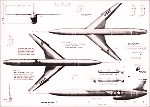 This 4-view drawing of the
Northrop SM-62 Snark
was scanned from page 21 of my purchased edition of the December 1957 American Modeler
magazine. It is another example of Walter Jefferies' fine scale drawings. First
U.S guided missile with intercontinental range, the tailless turbojet powered weapon
cruises at high sub-sonic speeds. With nuclear warhead and range of strategic jet
bombers, its range can be extended by addition of large pylon-mounted, underwing
auxiliary fuel tanks. Combination ailerons and elevators, called elevons, are mounted
on trailing edge of wing about mid-span... This 4-view drawing of the
Northrop SM-62 Snark
was scanned from page 21 of my purchased edition of the December 1957 American Modeler
magazine. It is another example of Walter Jefferies' fine scale drawings. First
U.S guided missile with intercontinental range, the tailless turbojet powered weapon
cruises at high sub-sonic speeds. With nuclear warhead and range of strategic jet
bombers, its range can be extended by addition of large pylon-mounted, underwing
auxiliary fuel tanks. Combination ailerons and elevators, called elevons, are mounted
on trailing edge of wing about mid-span...
 "A series of experiments using
paper airplanes reveals new aerodynamic effects, a team of scientists has discovered.
Its findings enhance our understanding of flight stability and could inspire new
types of flying robots and small drones. 'The study started with simple curiosity
about what makes a good paper airplane and specifically what is needed for smooth
gliding,' explains Leif Ristroph, an associate professor at New York University's
Courant Institute of Mathematical Sciences and an author of the study, which appears
in the Journal of Fluid Mechanics. 'Answering such basic questions ended up being
far from child's play. We discovered that the aerodynamics of how paper airplanes
keep level flight is really very different from the stability of conventional airplanes.'
'Birds glide and soar in an effortless way, and paper airplanes, when tuned properly,
can also glide for long distances..." "A series of experiments using
paper airplanes reveals new aerodynamic effects, a team of scientists has discovered.
Its findings enhance our understanding of flight stability and could inspire new
types of flying robots and small drones. 'The study started with simple curiosity
about what makes a good paper airplane and specifically what is needed for smooth
gliding,' explains Leif Ristroph, an associate professor at New York University's
Courant Institute of Mathematical Sciences and an author of the study, which appears
in the Journal of Fluid Mechanics. 'Answering such basic questions ended up being
far from child's play. We discovered that the aerodynamics of how paper airplanes
keep level flight is really very different from the stability of conventional airplanes.'
'Birds glide and soar in an effortless way, and paper airplanes, when tuned properly,
can also glide for long distances..."
 Since this membership application for the
Academy of Model Aeronautics (AMA) brings up the subject of inflation, I figured
it would be interesting to find out what the inflation rate was in 1949 when it
appeared in Air Trails magazine. According to the CPI Inflation Calculator, the
rate in 1949 was actually negative (-1.2%) due to a multi-year economic recession
triggered by President Truman's "Fair Deal"; however, in the previous year (1948)
it was a whopping 8.1%, and the year before that (1947) it was an incredible 14.4%!!!
So, massive inflation was definitely still on the minds of Americans at the time.
The current inflation rate (March 2022) is sitting at 8.5%, with no sign of things
getting any better. In fact, economists say if the inflation rate was calculated
the way it was in 1949, it would be in the 15% realm. According to the BLS Inflation
Calculator, what would have cost you $1.00 in September 1949 will cost you $12.03
in March of 2022. That's 1,203% inflation in about 73 years, which averages to about
1.102% per year (1.102^73 = 1,200). Clearly, we are currently in a period of significant
inflation, but that's what we get when the government prints money like mad and
dilutes the value of every dollar in your pocket... Since this membership application for the
Academy of Model Aeronautics (AMA) brings up the subject of inflation, I figured
it would be interesting to find out what the inflation rate was in 1949 when it
appeared in Air Trails magazine. According to the CPI Inflation Calculator, the
rate in 1949 was actually negative (-1.2%) due to a multi-year economic recession
triggered by President Truman's "Fair Deal"; however, in the previous year (1948)
it was a whopping 8.1%, and the year before that (1947) it was an incredible 14.4%!!!
So, massive inflation was definitely still on the minds of Americans at the time.
The current inflation rate (March 2022) is sitting at 8.5%, with no sign of things
getting any better. In fact, economists say if the inflation rate was calculated
the way it was in 1949, it would be in the 15% realm. According to the BLS Inflation
Calculator, what would have cost you $1.00 in September 1949 will cost you $12.03
in March of 2022. That's 1,203% inflation in about 73 years, which averages to about
1.102% per year (1.102^73 = 1,200). Clearly, we are currently in a period of significant
inflation, but that's what we get when the government prints money like mad and
dilutes the value of every dollar in your pocket...
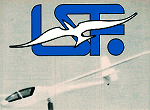 I remember back in the 1970s when I first
got into radio control flying, one of my planned accomplishments for life was to
polish my glider flying skills to the point that I could earn an LSF Level 5 rank.
Well, here I am at 62 and am lucky to get in a 20-minute thermal on a good day.
The reason for not attaining the lofty goal could blamed on lack of time, lack of
money, lack of opportunity, and lack of a lot of things, but the real cause is lack
of commitment. The guys who occupy the top slots are there because they have sacrificed
other things in order to be the best at
RC soaring. It was as true in
1974 as it is today in (gasp) 2022! In this December 1974 American Aircraft Modeler
magazine coverage of the League of Silent Flight Tournament, Mark Smith emerges
as the winner and debuts with his self-designed Windfree glider. He later marketed
the Windfree (99" wingspan) and the Windward (72" wingspan) as part of his Mark's
Models business... I remember back in the 1970s when I first
got into radio control flying, one of my planned accomplishments for life was to
polish my glider flying skills to the point that I could earn an LSF Level 5 rank.
Well, here I am at 62 and am lucky to get in a 20-minute thermal on a good day.
The reason for not attaining the lofty goal could blamed on lack of time, lack of
money, lack of opportunity, and lack of a lot of things, but the real cause is lack
of commitment. The guys who occupy the top slots are there because they have sacrificed
other things in order to be the best at
RC soaring. It was as true in
1974 as it is today in (gasp) 2022! In this December 1974 American Aircraft Modeler
magazine coverage of the League of Silent Flight Tournament, Mark Smith emerges
as the winner and debuts with his self-designed Windfree glider. He later marketed
the Windfree (99" wingspan) and the Windward (72" wingspan) as part of his Mark's
Models business...
 "Almost 75 years ago, U.S. Air Force pilot
Chuck Yeager became the first person to fly faster than the speed of sound. Engineers
have been pushing the boundaries of ultrafast flight ever since, attaining speeds
most of us can only imagine. Today, military fighter jets like the F−15 routinely
surpass Mach 2, which is shorthand for twice the speed of sound. That's supersonic
level. On a
hypersonic flight - Mach 5 and beyond - an aircraft travels faster than 3,000
miles per hour. At that rate, you could make it from New York to Los Angeles on
a lunch break. The same propulsion technology that goes into rockets has made hypersonic
speeds possible since the 1950s. But to make hypersonic flight more common and far
less expensive than a rocket launch, engineers and scientists are working on advanced
jet engine designs. These new concepts represent an enormous opportunity for commercial
flight, space exploration and national defense..." "Almost 75 years ago, U.S. Air Force pilot
Chuck Yeager became the first person to fly faster than the speed of sound. Engineers
have been pushing the boundaries of ultrafast flight ever since, attaining speeds
most of us can only imagine. Today, military fighter jets like the F−15 routinely
surpass Mach 2, which is shorthand for twice the speed of sound. That's supersonic
level. On a
hypersonic flight - Mach 5 and beyond - an aircraft travels faster than 3,000
miles per hour. At that rate, you could make it from New York to Los Angeles on
a lunch break. The same propulsion technology that goes into rockets has made hypersonic
speeds possible since the 1950s. But to make hypersonic flight more common and far
less expensive than a rocket launch, engineers and scientists are working on advanced
jet engine designs. These new concepts represent an enormous opportunity for commercial
flight, space exploration and national defense..."
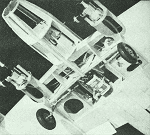 Can you imagine what a sweet sound it must
be with four Cox .049 engines running at the same time on the same airplane? Keith
Laumer and John Simmance didn't have to wonder once they teamed up to design, build,
and fly this 45" wingspan, control line
B-17
Flying Fortress. As if that wasn't enough, they added a custom electrical retractable
landing gear (including the tail wheel), navigation lights, throttles on all four
engines, and flaps! An 800:1 reduction gear box was coupled with a 3 volt motor
to drive the retract mechanism, flaps, throttles, and light switches. A third control
line and a Roberts 3-line bellcrank controlled everything. Operation of the retracts
is a bit dicey since they are triggered to go up at full throttle, then go back
down at low throttle. That means the pilot has to be careful not to command full
throttle while the model is on the ground or the landing gear will fold up on him.
I would not have wanted the task of trying to get all four Babe Bee .049 engines
running at the same time. Today we have commercially available electric starters
for the small engines, but in 1963 when this article appeared in American Modeler
magazine, it was either use the spring starter on the engine or flip it by hand... Can you imagine what a sweet sound it must
be with four Cox .049 engines running at the same time on the same airplane? Keith
Laumer and John Simmance didn't have to wonder once they teamed up to design, build,
and fly this 45" wingspan, control line
B-17
Flying Fortress. As if that wasn't enough, they added a custom electrical retractable
landing gear (including the tail wheel), navigation lights, throttles on all four
engines, and flaps! An 800:1 reduction gear box was coupled with a 3 volt motor
to drive the retract mechanism, flaps, throttles, and light switches. A third control
line and a Roberts 3-line bellcrank controlled everything. Operation of the retracts
is a bit dicey since they are triggered to go up at full throttle, then go back
down at low throttle. That means the pilot has to be careful not to command full
throttle while the model is on the ground or the landing gear will fold up on him.
I would not have wanted the task of trying to get all four Babe Bee .049 engines
running at the same time. Today we have commercially available electric starters
for the small engines, but in 1963 when this article appeared in American Modeler
magazine, it was either use the spring starter on the engine or flip it by hand...
|